Why Won’t My Baby Turtle Eat?
Petting a turtle is challenging, and it becomes more stressful when your baby pet turtle refuses the food. Besides throwing you at a nerve-racking situation, your turtle’s behavior makes you wonder, “why won’t my baby turtle eat?” Well, here you go.
Baby turtles and tortoises can reject food due to a lack of appetite and do the same thing when suffering from an illness. Apart from these two causes, some other reasons are associated with why they don’t eat.
In this guide, we have shared all the reasons why a baby turtle refuses to eat and also discussed the solution. Let’s read.
Read more about turtles blog:
Some Most Common Causes Why Your Baby Turtle Refuse To Eat:
Before you try to coax your beloved baby turtle to eat, you should first determine the causes of why it’s refusing its food. Below, we have briefly described the probable reasons so let’s check them out.
01. Stress:
Stress is one of the most common causes of why your turtle stops eating. Despite their hardy appearance, these species can be stressed out easily by improper handling, other pets, noises, and changes in environmental settings.
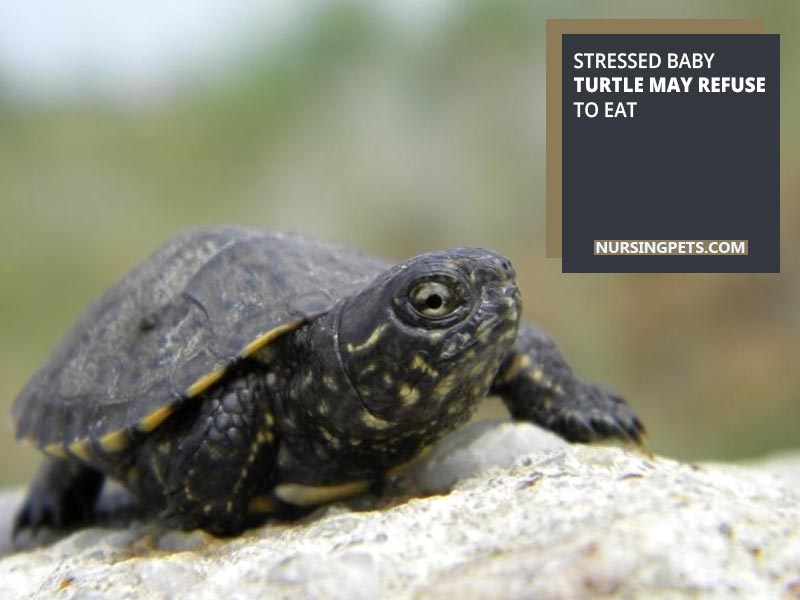
Whenever they get shifted, they become stressed and decline to intake food. But the good news is that the turtle will be calm with time once it adapts to the environment, and slowly everything will be normal.
02. Temperature:
Turtles are cold-blooded animals like many other reptiles, meaning they can’t produce body heat to keep themselves warm and comfy.
They rely on surrounding temperatures, so turtles limit their movement and even stop consuming food when the temperature drops.
Turtles require specific water temperatures to stay active in the water, and the required water temperature varies from species to species. Let’s have a look at the examples.
- The red-eared slider adult turtles prefer 75 to 80 degrees Fahrenheit to stay mobile, and baby turtles of this group require 80 to 85 degrees Fahrenheit water temperature.
- On the contrary, box turtles can live comfortably within 70 to 80 degrees Fahrenheit water temperatures.
So, if your tank’s temperature goes below 70 degrees Fahrenheit, those baby turtles may stop eating food.
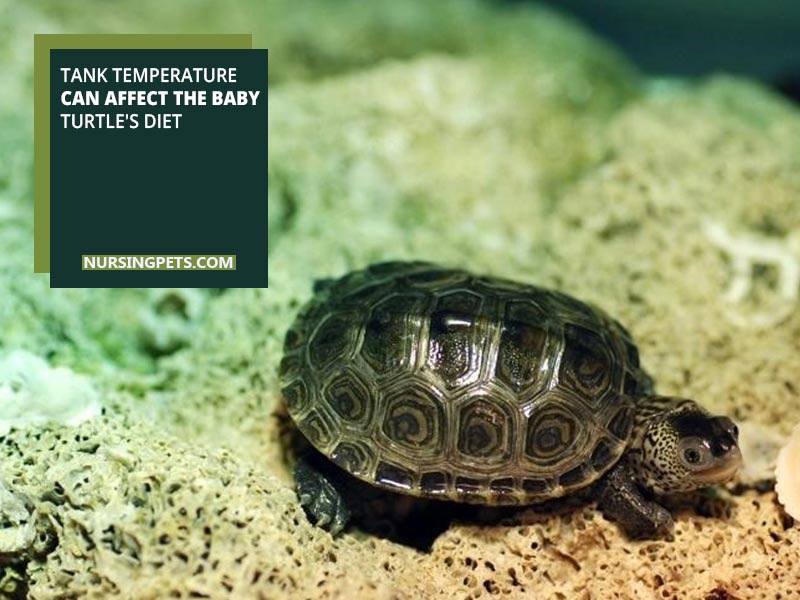
To solve this problem, you can utilize an underwater heater to maintain accurate water temperature. You can also use a heat lamp to keep your turtle warm if the temperature gets too cold.
03. Inappropriate Lighting:
Like water temperature, sunlight is essential for turtles to stay energetic. In essence, these species utilize UVB light to absorb the nutrients of consumed food.
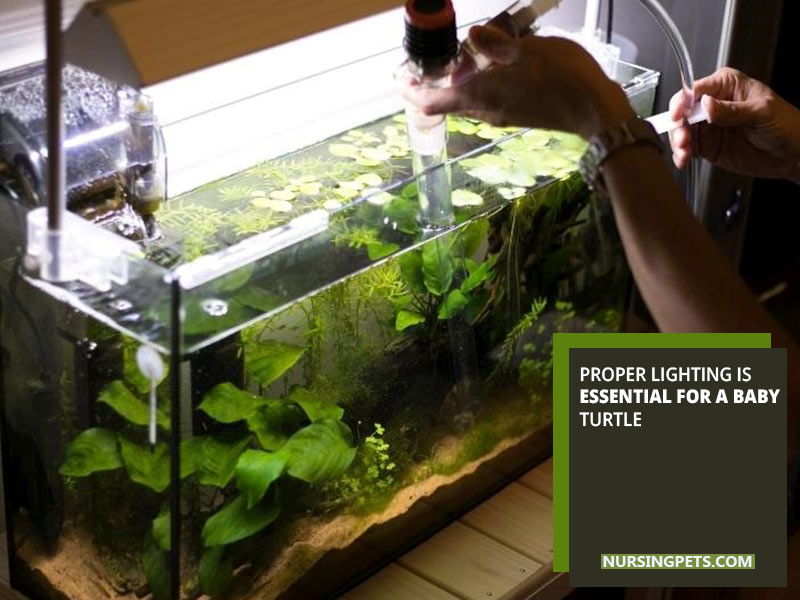
Most turtle types require 12 to 14 hours of UVB light every day. If they stop receiving this natural resource, they become lethargic and dampen their appetite.
So, you need to check your tank’s UVB bulb and search for whether it’s working or not. If it doesn’t work, you can add a brand new UVB light to the basking area of your aquarium to solve the lighting issue.
04. Diet:
Your turtle can refuse to eat food if you feed it incorrectly. Most baby turtles tend to consume more meat and protein than pellets, vegetables, and fruits.
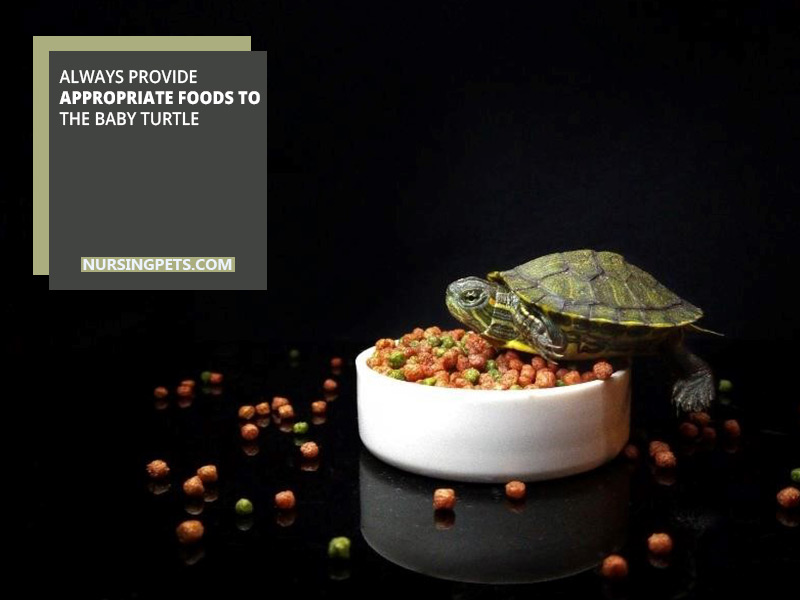
That’s why you need to research your baby turtle’s diet based on its species before opting to feed it. However, to help you out, we have shared the best diet plans for popular baby turtles species below.
- Box turtles, especially hatchlings, are carnivorous and frequently decline to eat pellets. Instead, they gobble crickets, nightcrawlers, bloodworms, steamed chicken, raw fish, and other meat-based meals.
- Baby musk turtles are also meat eaters, but you won’t have a hard time feeding them vegetables or fruit. Besides offering these turtles earthworms, crickets, meat pellets, and feeder guppies, you can provide them with a wide variety of veggies and fruits.
- Red-eared slider baby turtles love consuming high-protein pellets, especially supplemented with crickets, earthworms, or fish. Besides pellets, you can feed them romaine lettuce occasionally.
- African sideneck turtles prefer eating nightcrawlers, feeder fish, and shrimp when they are young. Some may scorn consuming pellets.
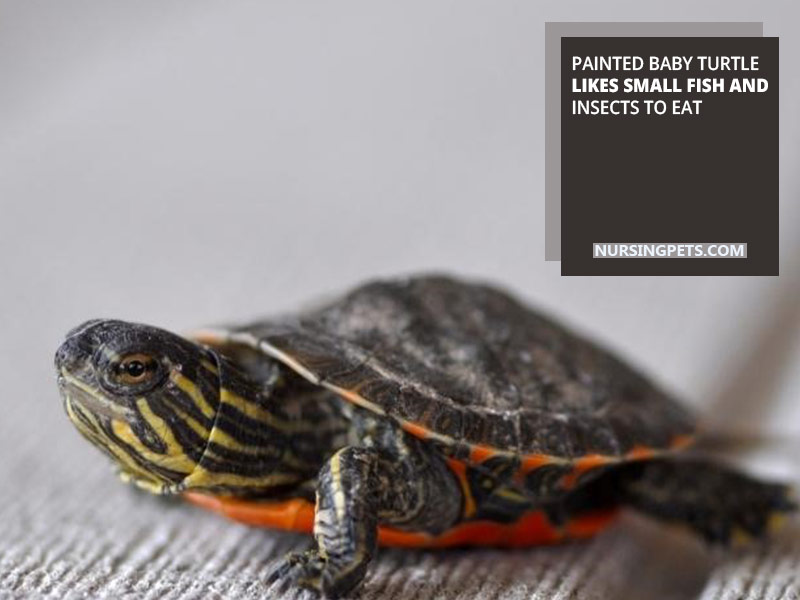
- Painted turtle hatchlings like to eat small fish and insects. They also feed on algae and leafy veggies. But the best fact about them is that they accept pellets from a young age.
- Baby map turtles’ diet contains pellets and live foods, including small insects, fish, and worms.
- Baby snapping turtles love consuming worms, bugs, feeder fish, and tiny snails. You can also feed them leafy veggies weekly.
- Finally, if you wonder, “what do baby water turtles eat?” here you go: they eat earthworms, beetles, grasshoppers, slugs, frogs, crickets, mealworms, tadpoles, and more.
Basically, baby turtles follow a high-protein diet for the first six to twelve months of their lives, and they will gradually move to an omnivore diet once they surpass the baby phase.
05. Illness:
Your pet turtle can refuse to consume food if it suffers from the illness. Below, we have shared some common symptoms you can notice in a turtle hatchling when it is sick. Let’s check them out.
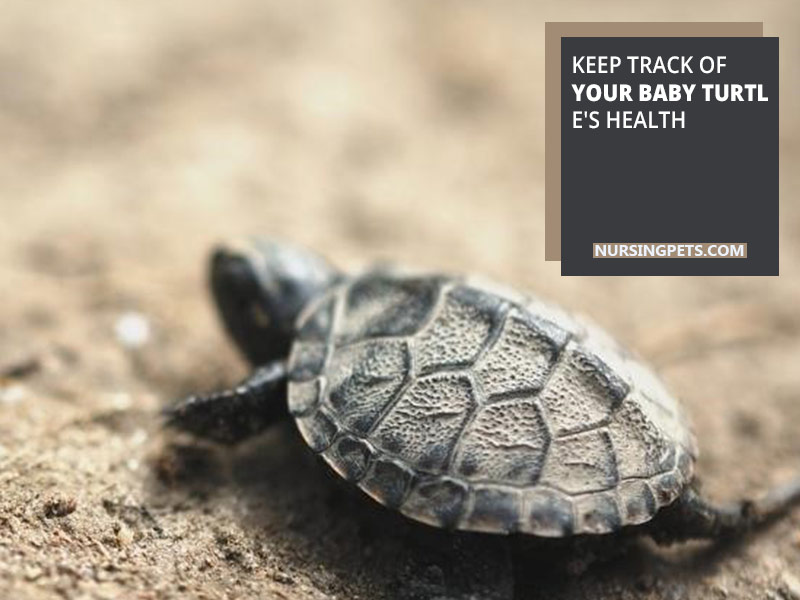
- Your turtle will sneeze, wheeze, face difficulty breathing, or its peepers appear swollen and irritated when it falls sick.
- The baby turtle’s shell may discolor when it becomes ill and fails to receive vitamin A in its diet.
- Your pet turtle may be constipated, so it can refuse food. If you don’t see any feces in the tank, it’s a sure sign the baby turtle is being constipated.
- Sometimes the baby turtle declines to consume food when it has a parasitic infection, and the sign of such an infection is you may see worms in its feces.
- If your turtle doesn’t get enough calcium through food, it can dampen its appetite. Hence, you can offer it a calcium supplement along with a regular diet. You may put cuttlebones and calcium blocks in its tank to let it have the calcium supplement.
These are some common illnesses baby turtles suffer regularly; when they do, they won’t eat anything.
06. Water Condition:
We humans don’t prefer eating at a dirty table, nor do the turtles. They don’t like to eat in filthy water. Thus, you need to clean your turtle tank weekly.
If you forget to clean, your turtle may stop eating and can develop serious health problems, which you indeed don’t want.
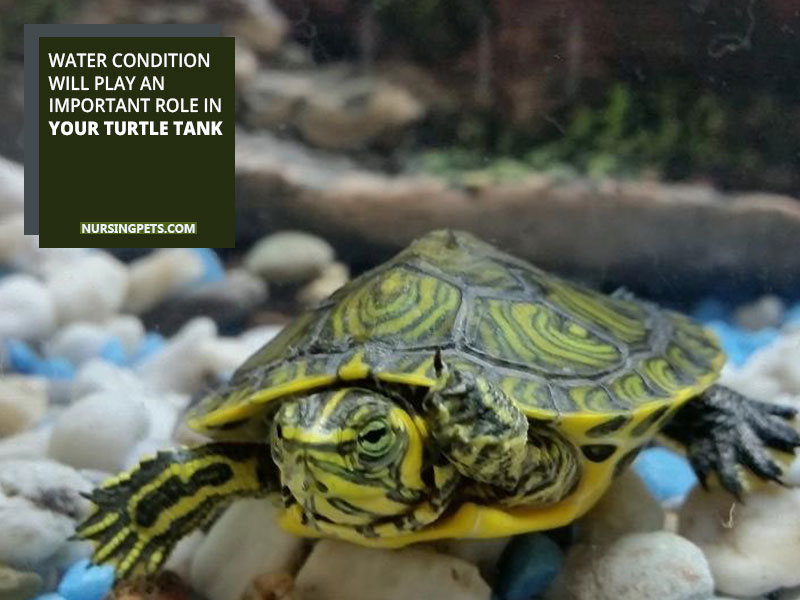
In case cleaning the turtle tank seems a hassle, you can purchase the best quality water filter according to your requirement. Until you get one, let’s discuss how you should feed the turtle hatchling.
You can keep the turtle in a separate aquarium or container filled with water and feed it. Once it finishes eating, you should keep the baby turtle in that place for a couple of minutes and then put it back in the tank.
If you pet several baby turtles, you should feed them one by one, not all at once. And that’s how you can feed your turtles when their tank water is dirty.
07. Feeding Time:
Your baby turtle can rebuff eating food if you offer it at the wrong time. Yes, turtles follow a food-consuming schedule, and they gobble food early in the day or late in the afternoon when they have better appetites.
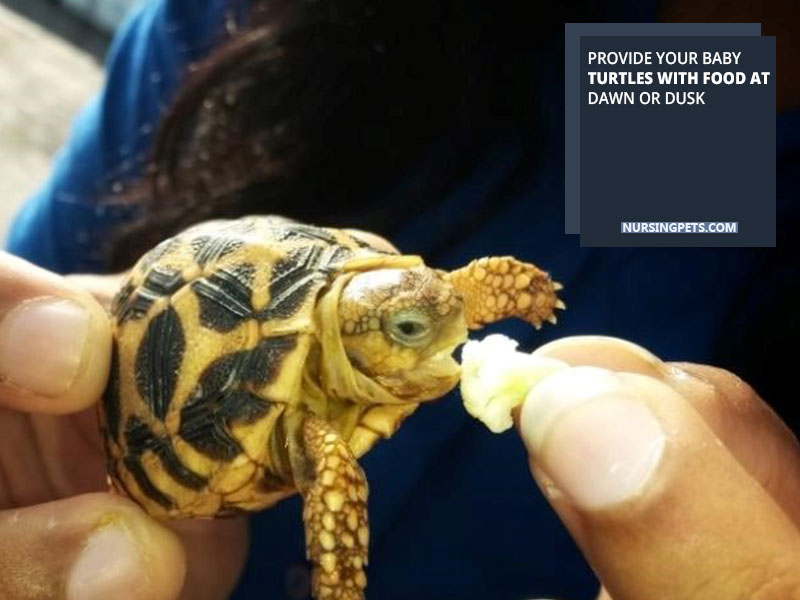
If you try to feed turtles midday or in the evenings, there is a high chance they won’t feed on food due to sluggishness.
So, you should provide your pet turtles with food at dawn or dusk to determine whether the eating schedule is why they avoid taking food.
08. Hibernation:
Turtles tend to hibernate when the temperature drops, and these reptiles will drastically reduce their activities and stop gobbling food at the beginning of hibernation.
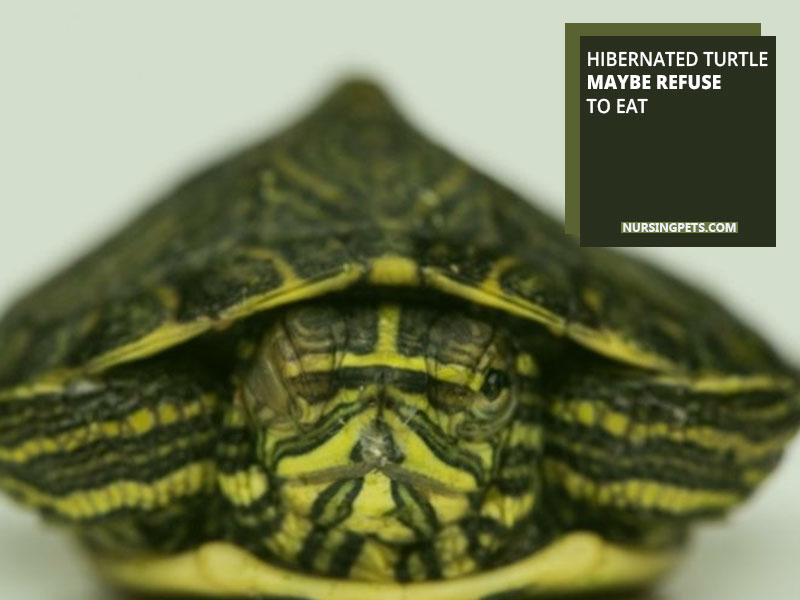
Some turtles also brumate instead of hibernating during the fall and winter. It happens when your pet turtle suffers from health problems.
So, whenever you notice your baby turtle stops eating in the fall or winter, you can increase the tank water temperature, and still, if you see that the baby turtle isn’t returning to its normal life, you should bring it to the vet.
09. Shyness:
Some turtles, such as box turtles, don’t like being monitored while consuming food and exhibit this kind of behavior at an early age.
So, if you own a box turtle or any other turtle that is a shy eater, it may not intake food when you are around. After offering your pet turtles food, you can leave the room to avert the problem.
10. Scared:
If you have brought pet turtles recently, it’s normal for these reptiles not to feed on food for a couple of days in the new environment.
Baby turtles remain scared when shifted to new places, and they require some time to get back to normal life. So, after getting your new pets and putting them in the tank, you should give them a while to let them calm down.
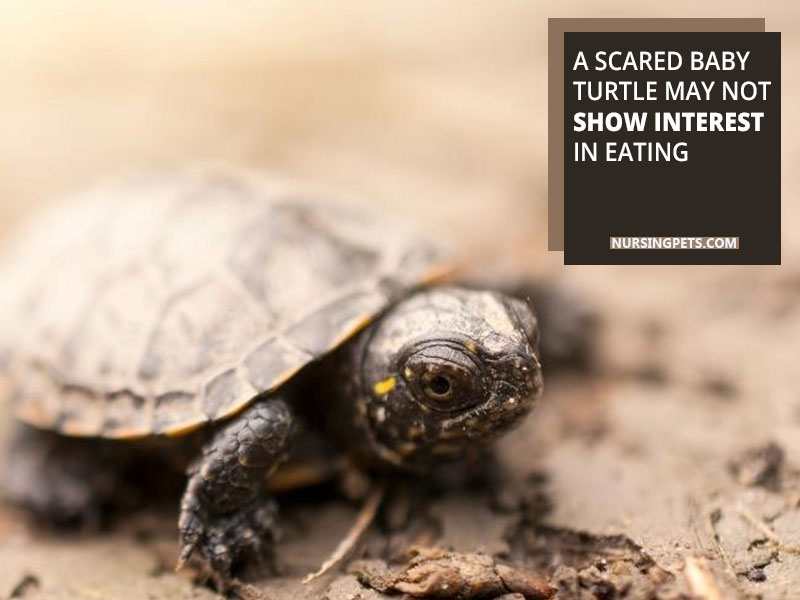
Usually, most turtles take one week to be normal, but you should remember every turtle is different. Hence, you must have patience during this time.
These are all the probable reasons why your baby pet turtle refuses to eat food. Now, let’s discuss what steps you can follow to help your turtle consume food.
How Long Can Baby Turtles Go without Eating?
Numerous pet keepers often face the problem of their turtles not consuming food, and consequently, they think about how long their pets can go without eating.
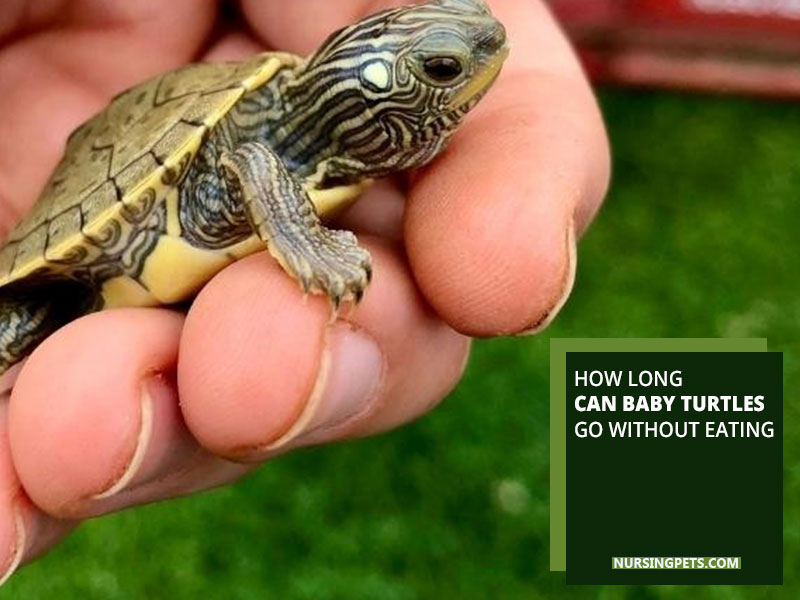
Based on what turtle species they pet, some people wonder, “how long can a baby snapping turtle go without eating?” and some think, “how long can a box turtle go without consuming food?“. Let’s find out.
- A six-month-old baby turtle can’t go a day without food.
- Turtles, whose age ranges from six months to twelve months, can’t also go more than a day without food.
- Adult turtles can make it, but they should consume food every two to three days.
These statements apply to all turtle species, but FYI turtles can fast for a few days after a heavy meal, and this incident isn’t regular.
How to Entice Your Baby Turtle to Eat Food?
Although we have already shared some tips on feeding your turtles, we will talk about some more effective methods to help you get rid of the issue concerning “how do you make a baby turtle eat?“. Let’s get started.

Offer Live Food:
Turtles are attracted to the movement of their targets and energetically go after live food, such as crickets, waxworms, earthworms, snails, mealworms, and other small insects.
So, you can provide your pet turtle with such food types when it refuses to eat. But ensure those foods are fresh and have never been treated with chemicals.
Mix Pellets with Other Foods:
Sometimes baby turtles decline intaking pellets even though this food remains a staple in their diet. Thus, you become worried and constantly contemplate how to feed a baby turtle pellets.
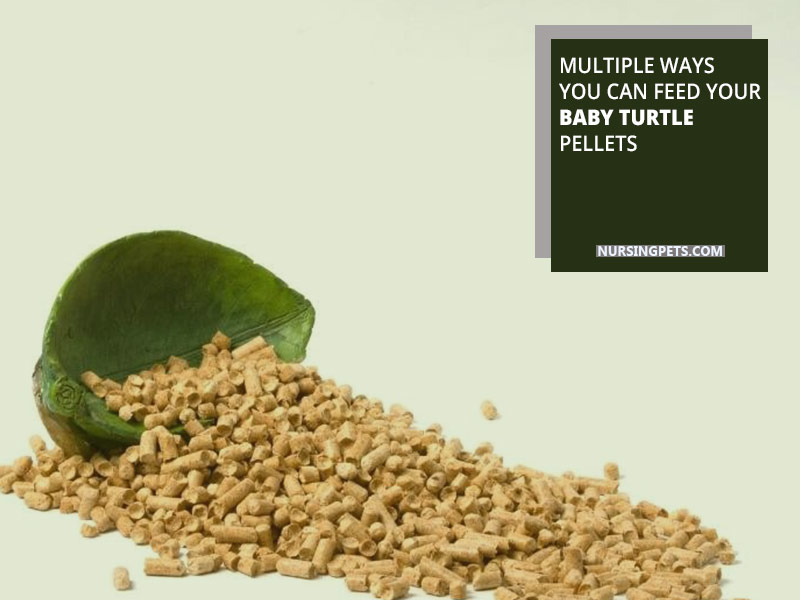
When your pet turtle refuses to consume pellets, you can crush them and mix them with live food to lure your turtle into eating.
Besides mixing pellets with live food, you can soak them in canned tuna water to give them a solid and enticing aroma. Also, you can soak the pellets in juice or non-caffeinated drinks to enchant your pet turtle to consume food.
Provide Colorful Food:
Turtles find colorful foods incredibly enticing. If you wonder, “what fruits can baby turtles eat? “
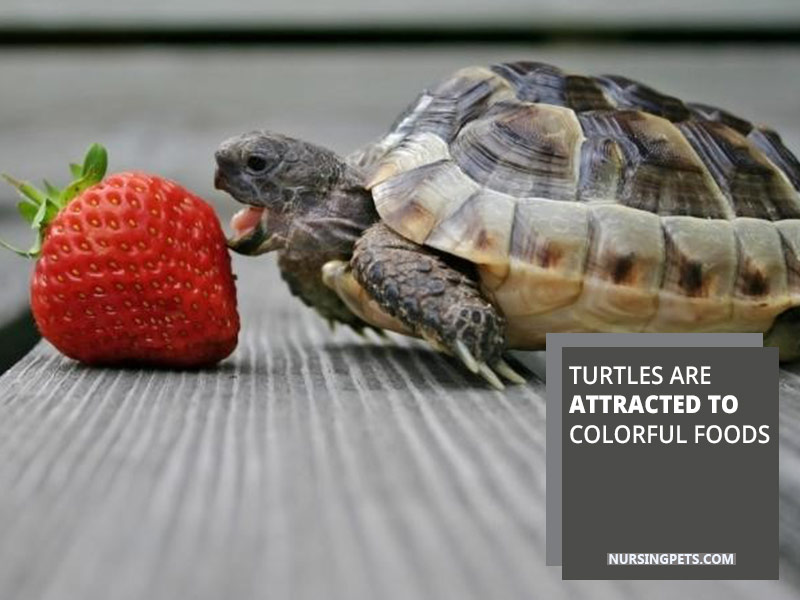
You can offer your pet turtle a small portion of strawberries, papaya, mango, watermelon, apple, bananas, berries, cantaloup, and other colorful veggies and fruits when it refuses to eat.
Like the pallets, you can mix these veggies and fruits with live food or soak them in tuna water or juice to give them a solid smell and encourage turtles to consume food.
Change The Diet:
You should play with the turtle’s diet and avoid offering your pet turtle the same food daily. Instead, you can provide veggies and pellets one day and serve your turtle fruits and pellets the next day.
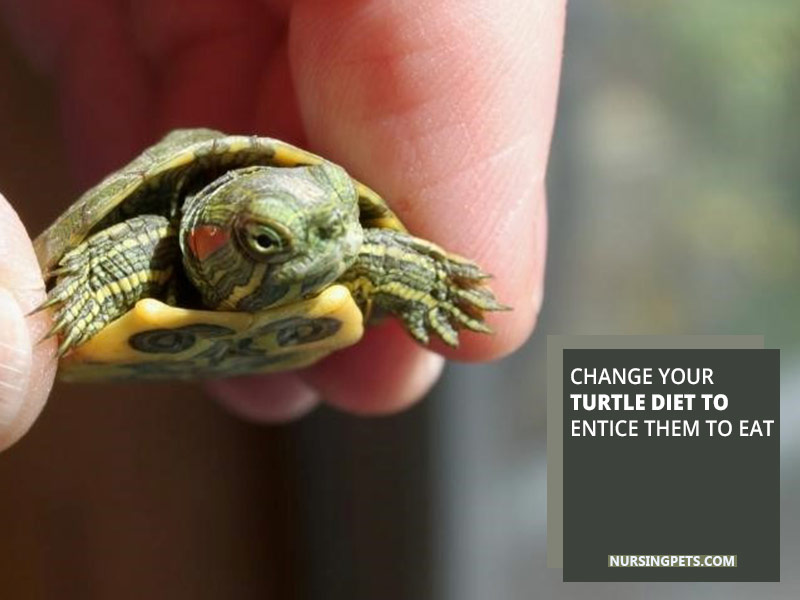
Again, you can give them a mix of vegetables and pellets soaked in tuna water or juice on the third day. The point here is to try to switch up turtles’ diet to help them like the food.
So, these are all the methods you can follow to get your baby turtles to eat the food regularly and happily. By following these tips, you won’t have to think about “how do I feed a baby turtle that won’t eat?“.
How Do You Force-Feed A Baby Turtle?
You can’t always lure your baby turtle into eating, so to solve this problem, you may need to force-feed the baby reptile. Here’s how you should perform this job.
First, place the baby turtle in a container filled with water. Then, soften the pellets you’ve taken in a pot with water. Additionally, you can add multivitamins and mix them well with pellets.
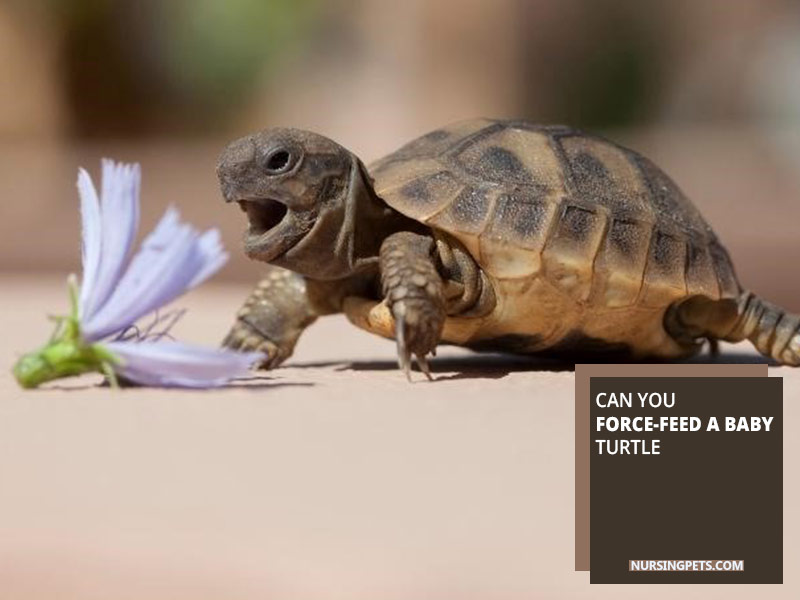
Afterward, pour the food mixture into a 10ml syringe and then transfer the food to a 1ml syringe, as the 10ml syringe won’t fit into the baby turtle’s mouth.
Hold the baby turtle upright; it will be better to hold it at a 45-degree angle to prevent your pet from choking. Now, swiftly rub the turtle’s front leg or nose to make it open its mouth.
FYI, turtles open their mouths to defend themselves when threatened. Finally, aim the 1ml syringe at the baby turtle’s mouth and push the syringe’s plunger to force-feed the turtle.
Lastly, place the baby turtle in the container again in its natural position for one to two minutes to enable it to drink water and swallow food.
Now, fill another 1ml syringe with food and repeat the entire process. To complete feeding 10 ml food may require you to spend around 15 to 20 minutes. Thus, have patience.
Well, we have talked about how to force-feed your baby turtle. But should you force your turtle to eat?
In some cases, force-feeding is necessary, especially for baby turtles, since they don’t know yet what is good for them.
Frequently Asked Questions
01. How Often Do Baby Turtles Eat?
Baby turtles need to eat two to three times a day. Plus, they need vitamins and supplements for healthy growth. As they grow old, these reptiles can go a day without food.
02. What Can Baby Turtles Eat From Human Food?
You can feed baby turtles human food like leafy vegetables, including romaine lettuce and cabbage. You can also feed them a small chunk of various fruits.
03. What Happens If Your Baby Turtle Doesn’t Eat?
Although turtles can make it up to two weeks without food, even in their most active period, they will die if they remain unfed longer than the period mentioned above. Thus, feed your pet timely and take good care of it.
04. Do You Need to Visit a Vet If Baby Turtle Won’t Eat?
Of course, if your baby turtle doesn’t eat, it’s best to discuss it with a professional vet to identify the problem. However, our recommended suggestions can also help with the situation. But visiting a vet is the best thing to do.
Wrapping Up:
Now you know why your baby pet turtles refuse the food. There can be myriad reasons ranging from environmental changes to a lack of appetite. So, whatever the causes are, they are solvable by following the steps we have already discussed in this content.
However, if you still face issues with turtles’ not eating food after applying all the techniques, you should bring your pet to the reptile veterinarian. That’s all for this article; we hope you loved it and will share it with your friends and family via Facebook, Twitter & Pinterest.
Image Source: Canva.com/photos
Article Reference:
- https://www.lovetoknowpets.com/reptiles/reasons-why-my-turtle-isnt-eating
- https://www.animalwised.com/why-is-my-turtle-not-eating-possible-causes-and-solutions-4052.html

